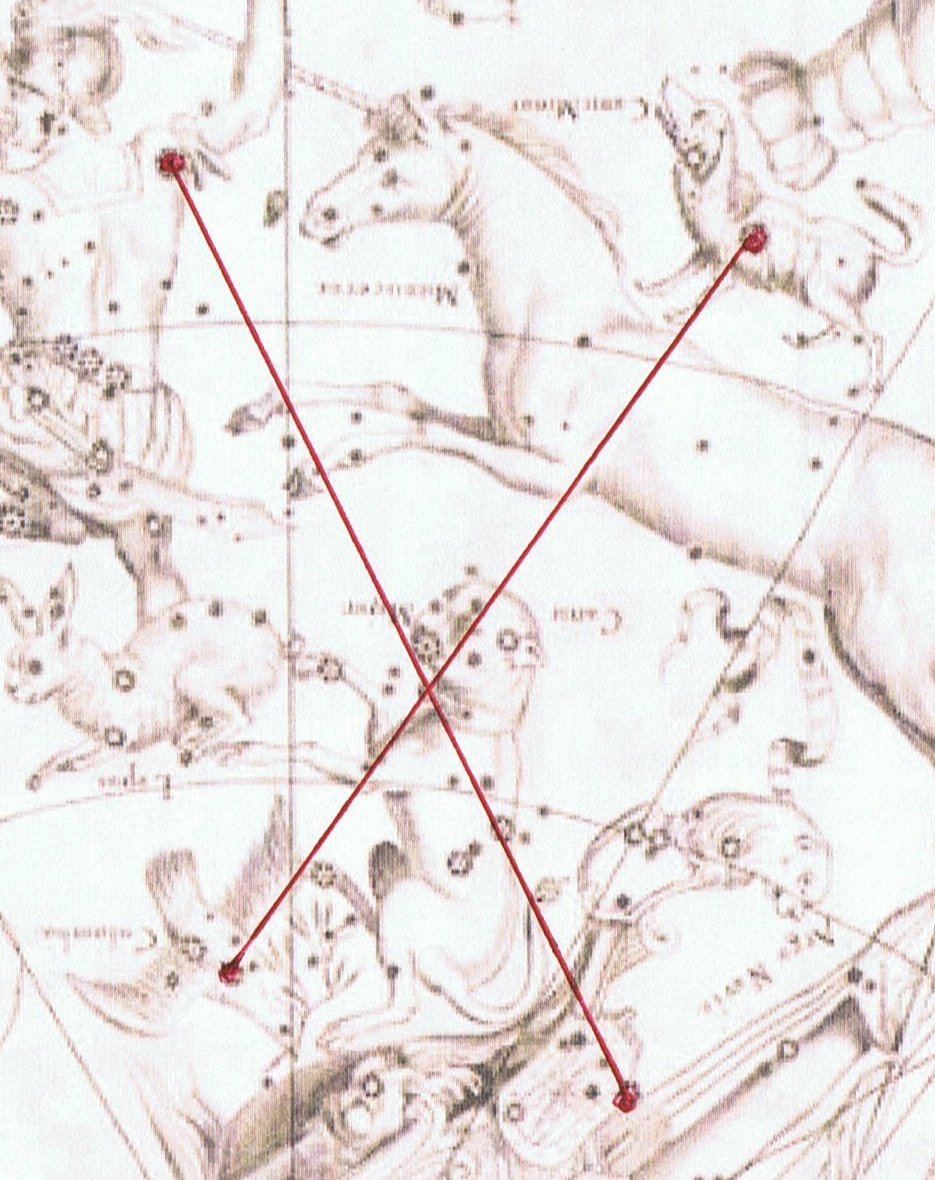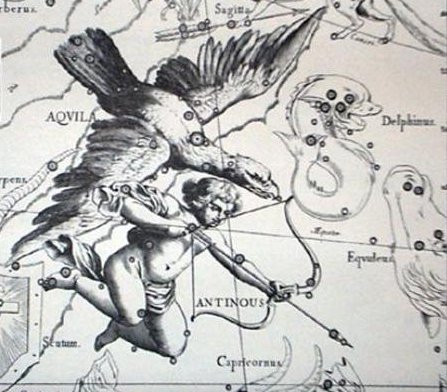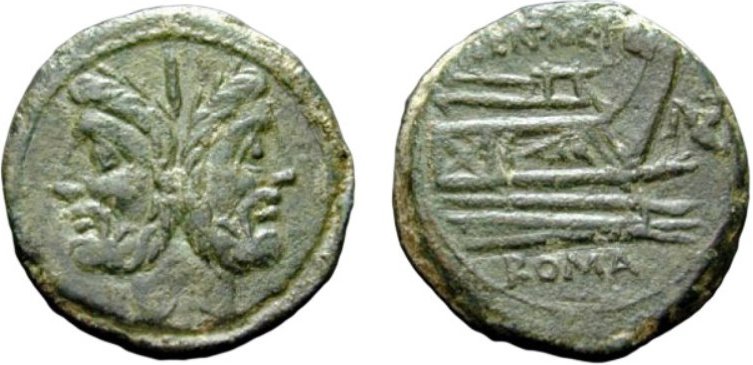Probably the Babylonian 'Mouth of the Twins' corresponded to a place similar to that which in Roman times had been known as the 'Gate of Cancer'. A 'mouth' can alternatively be named a 'gate', a 'door', etc. ... All 'change stations' are found invariably in two regions: one in the South between Scorpius and Sagittarius, the other in the North between Gemini and Taurus; and this is valid through time and space, from Babylon to Nicaragua. Why was it ever done in the first place? Because of the Galaxy, which has its crossroads with the ecliptic between Sagittarius and Scorpius in the South, and between Gemini and Taurus in the North ... Men's spirits were thought to dwell in the Milky Way between incarnations. This conception has been handed down as an Orphic and Pythagorean tradition fitting into the frame of the migration of the soul. Macrobius, who has provided the broadest report on the matter, has it that souls ascend by way of Capricorn, and then, in order to be reborn, descend again through the 'Gate of Cancer'. Macrobius talks of signs; the constellations rising at the solstices in his time (and still in ours) were Gemini and Sagittarius: the 'Gate of Cancer' means Gemini. In fact, he states explicitly (I,12.5) that this 'Gate' is 'where the Zodiac and the Milky Way intersect'. Far away, the Mangaians of old (Austral Islands, Polynesia), who kept the precessional clock running instead of switching over to 'signs', claim that only at the evening of the solstitial days can spirits enter heaven, the inhabitants of the northern parts of the island at one solstice, the dwellers in the south at the other ... Considering the fact that the crossroads of ecliptic and Galaxy are crisis-resistant, that is, not concerned with the Precession, the reader may want to know why the Mangaians thought they could go to heaven only on the two solstitial days. Because, in order to 'change trains' comfortably, the constellations that serve as 'gates' to the Milky Way must 'stand' upon the 'earth', meaning that they must rise heliacally either at the equinoxes or at the solstices. The Galaxy is a very broad highway, but even so there must have been some bitter millenia when neither gate was directly available any longer, the one hanging in midair, the other having turned into a submarine entrance ... There were 27 precessional days down to Roman times and therefore the date May 24 (144 = 12 * 12) at the beginning of side a on the G tablet corresponded to the Roman date 'May 24 at Ga1-27:
The 'Exit Door' for Father Light (Jupiter) - who every year was creating a 'virgin earth' between spring equinox and summer solstice - could have been just in front of heliacal Canopus. ... At the end of the Golden Age (Krita Yuga) a class of Asura who had fought against the 'gods' hid themselves in the ocean where the gods could not reach them, and planned to overthrow the government. So the gods implored Agastya (Canopus, alpha Carinae = Eridu) for help. The great Rishi did as he was bidden, drank up the water of the ocean, and thus laid bare the enemies, who were then slain by the gods. But now, there was no ocean anymore! Implored by the gods to fill the sea again, the Holy One replied: 'That water in sooth hath been digested by me. Some other expedient, therefore, must be thought of by you, if ye desire to make endeavour to fill the ocean ... But the Tahitian star pillar list had Phakt (Ana-iva, α Columbae) as its 'pillar of exit', and due to the precession there should have been several such exit places through the ages. Although when the Egyptian X asterism crossed over Canis Major where the Sun moved up from Phakt to Procyon it suggested a 'door of entrance'. South of the equator the seasons were upside down compared to the situation north of the equator.
Procyon followed in the day after Castor and then came the Unicorn in the day before Pollux. Possibly these 4 days could have formed a 'Gate at Gemini':
And half a year later there should then be a complementary Entrance Door for Jupiter to return through, where he could be 'reborn':
... The divine names Bran, Saturn, Cronos ... are applied to the ghost of Hercules that floats off in the alder-wood boat after his midsummer sacrifice. His tanist, or other self, appearing in Greek legend as Poeas who lighted Hercules' pyre and inherited his arrows, succeeds him for the second half of the year; having acquired royal virtue by marriage with the queen, the representative of the White Goddess, and by eating some royal part of the dead man's body - heart, shoulder or thigh-flesh. He is in turn succeeded by the New Year Hercules, a reincarnation of the murdered man, who beheads him and, apparently, eats his head. This alternate eucharistic sacrifice made royalty continous, each king in turn the Sun-god beloved of the reigning Moon-goddess. But when these cannibalistic rites were abandoned and the system was gradually modified until a single king reigned for a term of years, Saturn-Cronos-Bran became a mere Old Year ghost, permanently overthrown by Juppiter-Zeus-Belin though yearly conjured up for placation at the Saturnalia or Yule feast ...
In his monumental The White Goddess Robert Graves has stated that the month of Jupiter ended 'of July 7'. Such a significant date could not change and instead the precession would steadily have pushed the stars ahead in the calendar for the Sun year.
... Midsummer is the flowering season of the oak, which is the tree of endurance and triumph, and like the ash is said to 'court the lightning flash'. Its roots are believed to extend as deep underground as its branches rise in the air - Virgil mentions this - which makes it emblematic of a god whose law runs both in Heaven and in the Underworld ... The month, which takes its name from Juppiter the oak-god, begins on June 10th and ends of July 7th. Midway comes St. John's Day, June 24th, the day on which the oak-king was sacrificially burned alive. The Celtic year was divided into two halves with the second half beginning in July, apparently after a seven-day wake, or funeral feast, in the oak-king's honour ... Consequently I maybe should avoid to connect the days in these 4 weeks with the heliacal stars at the time of rongorongo - however tempting it might be due to the return of the major stars to their ancient cardinal points. Precisely at the time of rongorongo they had moved so far ahead from the beginning of 'Earth' that they had reached to its end, where 'Water' would take over. Therefore, once again the Milky Way would here serve its function to transport the souls to be reborn. This could well have motivated the creation of the rongorongo tablets. ... Considering the fact that the crossroads of ecliptic and Galaxy are crisis-resistant, that is, not concerned with the Precession, the reader may want to know why the Mangaians thought they could go to heaven only on the two solstitial days. Because, in order to 'change trains' comfortably, the constellations that serve as 'gates' to the Milky Way must 'stand' upon the 'earth', meaning that they must rise heliacally either at the equinoxes or at the solstices.they must rise heliacally either at the equinoxes or at the solstices ... There was 'apparently' a 7day wake after July 7, and at the time of rongorongo July 15 happened to be where Pollux rose heliacally, i.e. in day 1 after α Monocertotis:
The G text would evidently have been possible to use as a calendar for the Sun year. For instance, by counting 68 precessional days down to the time of Hyadum II we could easily adjust the dates accordingly:
But at the time of rongorongo May 1 was at heliacal Bharani:
From the illustrations in Gb4-22 and Ga1-29 it seems clear that the life force (vai ora) emerging from the head at Bharani had dried out at the left foot of Castor, 52 days later.
This sweet water force - or spirit of life - came by way of the Sun (Tane): ... When the new moon appeared women assembled and bewailed those who had died since the last one, uttering the following lament: 'Alas! O moon! Thou has returned to life, but our departed beloved ones have not. Thou has bathed in the waiora a Tane, and had thy life renewed, but there is no fount to restore life to our departed ones. Alas ... It was made explicit in the so-called Moon calendar on the C tablet, for instance in Ca6-21:
... There is a couple residing in one place named Kui and Fakataka. After the couple stay together for a while Fakataka is pregnant. So they go away because they wish to go to another place - they go. The canoe goes and goes, the wind roars, the sea churns, the canoe sinks. Kui expires while Fakataka swims. Fakataka swims and swims, reaching another land. She goes there and stays on the upraised reef in the freshwater pools on the reef, and there delivers her child, a boy child. She gives him the name Taetagaloa. When the baby is born a golden plover flies over and alights upon the reef. (Kua fanau lā te pepe kae lele mai te tuli oi tū mai i te papa). And so the woman thus names various parts of the child beginning with the name 'the plover' (tuli): neck (tuliulu), elbow (tulilima), knee (tulivae) ...
The Gemini Twins looked each other in the eye (face) - they were as equals. They were not looking in opposite directions as the single Janus half a year later.
|
||||||||||||||||||||||||||||||||||||||||||||||||||||||||||||||||||||||||||||||||||||||||||||||||||||||||||||||||||||||||||||||||||||||||||||||||||||||||||||||||||||||||||||||||||||||||||||||||||||||||||||||||||||||||||||||||||















